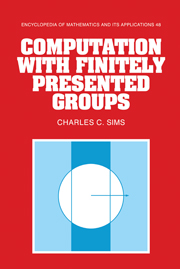Book contents
- Frontmatter
- Contents
- Preface
- Introduction
- 1 Basic concepts
- 2 Rewriting systems
- 3 Automata and rational languages
- 4 Subgroups of free products of cyclic groups
- 5 Coset enumeration
- 6 The Reidemeister-Schreier procedure
- 7 Generalized automata
- 8 Abelian groups
- 9 Polycyclic groups
- 10 Module bases
- 11 Quotient groups
- Appendix Implementation issues
- Bibliography
- Index
3 - Automata and rational languages
Published online by Cambridge University Press: 06 March 2010
- Frontmatter
- Contents
- Preface
- Introduction
- 1 Basic concepts
- 2 Rewriting systems
- 3 Automata and rational languages
- 4 Subgroups of free products of cyclic groups
- 5 Coset enumeration
- 6 The Reidemeister-Schreier procedure
- 7 Generalized automata
- 8 Abelian groups
- 9 Polycyclic groups
- 10 Module bases
- 11 Quotient groups
- Appendix Implementation issues
- Bibliography
- Index
Summary
The theory of formal languages is an important part of theoretical computer science. The theory classifies subsets of free monoids according to the difficulty of deciding whether a given word belongs to the subsets. From this point of view, the simplest subsets are the finite ones. The next simplest are called rational languages. If £ is a rational language, then £ may be infinite, but there is a finite combinatorial object called an automaton with which one can decide whether a word U belongs to £ in time proportional to |U|.
One of the first papers to suggest a connection between combinatorial group theory and formal language theory was (Anisimov 1971). Other authors have pursued this topic. See for example (Muller & Schupp 1983, 1985) and (Gilman 1984b, 1987). However, the work which has stirred up the greatest interest in formal language theory among group theorists is [Epstein et al. 1992], This book has no less than six authors and the intriguing title Word Processing and Group Theory. One of its most important contributions is the definition of a class of groups in which the multiplication and comparison of elements can be described using automata. Such groups are said to have an automatic structure.
We shall not attempt here an exposition of the theory of groups with an automatic structure. However, the present chapter provides an introduction to a number of applications of automata in combinatorial group theory. Automata can be used as index structures to rewriting systems. Automata also appear in one approach to studying right congruences on finitely presented monoids using the Knuth-Bendix procedure for strings.
Information
- Type
- Chapter
- Information
- Computation with Finitely Presented Groups , pp. 96 - 150Publisher: Cambridge University PressPrint publication year: 1994
